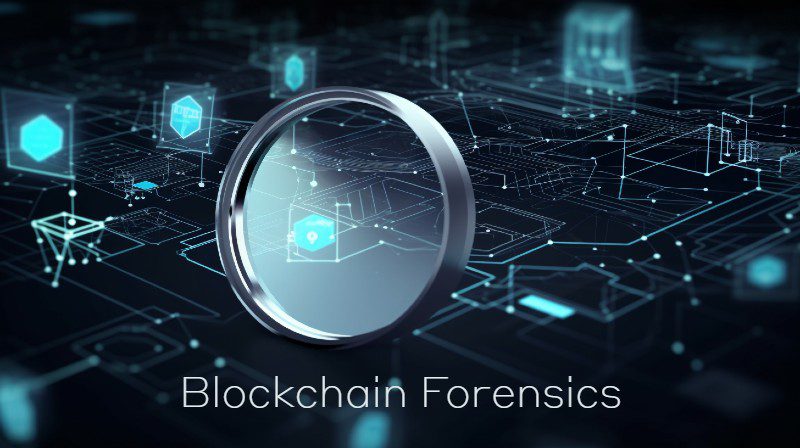
Blockchain technology has revolutionized the world of finance and digital transactions. With its decentralized, transparent, and secure architecture, it has become an essential component of the modern digital economy. However, as the popularity of cryptocurrencies and blockchain-based applications continues to rise, so does the need for effective tools to analyze, monitor, and trace transactions on the blockchain. Blockchain forensics is an emerging discipline that helps to unveil the power of transparency and security inherent in blockchain technology.
In this article, we delve into the world of blockchain forensics, exploring the techniques and tools that enable the detection of fraudulent activities, ensuring regulatory compliance, and identifying the source of transactions within the blockchain ecosystem. By understanding the principles and practices of blockchain forensics, we can better appreciate the value it brings to the blockchain landscape in terms of security and transparency.
What is Blockchain Forensics?
Blockchain forensics refers to the process of investigating, analyzing, and tracing transactions on a blockchain network, with the objective of detecting fraudulent activities, ensuring regulatory compliance, and identifying the sources of transactions. This field combines expertise in cybersecurity, data analysis, and cryptography to provide insights into the complex world of blockchain transactions.
|
Blockchain Type |
Forensic Capability |
Advantages |
Limitations |
|
Public |
High |
Transparent, easily accessible data |
Privacy concerns, potential exposure of user data |
|
Private |
Limited |
Controlled access, increased privacy for participants |
Limited data accessibility, reduced transparency |
Table 1: Comparison of Public and Private Blockchain Forensic Capabilities
Why is Blockchain Forensics Important?
As blockchain technology becomes increasingly integrated into various industries, its security and transparency features have become critical to ensuring trust and reliability. Blockchain forensics plays a vital role in maintaining these characteristics by:
- Detecting Fraud and Illicit Activities: Blockchain forensics allows experts to trace transactions and identify patterns that may indicate fraudulent or illicit activities, such as money laundering, terrorist financing, or market manipulation. By monitoring and analyzing the blockchain, forensic experts can detect suspicious activities and help prevent potential security breaches.
- Ensuring Regulatory Compliance: As governments around the world implement regulations to govern the use of cryptocurrencies and blockchain technology, compliance with these rules becomes essential. Blockchain forensics enables businesses and individuals to demonstrate compliance with Anti-Money Laundering (AML) and Know Your Customer (KYC) requirements, ensuring the legitimacy of their operations and transactions.
- Strengthening Security: Blockchain forensics contributes to the overall security of the blockchain ecosystem by identifying vulnerabilities and threats. Through a thorough analysis of the transaction history and patterns, forensic experts can uncover potential weaknesses and implement measures to enhance the security of blockchain networks.
Throughout this article, we explore the top tools available for blockchain forensics analysis, discuss how blockchain forensics enhance security in cryptocurrency transactions, examine the role of blockchain forensics in regulatory compliance and legal cases, and finally, look into the challenges and opportunities that lie ahead in the future of blockchain forensics. Discover how blockchain forensics is shaping the future of transparency and security in the digital realm.
Top Blockchain Forensic Tools: A Comprehensive Analysis
The success of blockchain forensics relies heavily on the tools used to analyze and monitor transactions. Several tools have emerged to cater to the growing need for blockchain forensics, each offering unique features and capabilities. In this segment, we explore some of the top blockchain forensic tools available in the market, highlighting their key features, advantages, and use cases.
|
Tool |
Key Features |
Use Cases |
|
Chainalysis |
KYT, Reactor, Kryptos, Compliance APIs, Multi-currency support |
AML compliance, law enforcement, regulators |
|
Elliptic |
AML, KYC, transaction monitoring, risk assessment, enterprise APIs |
Financial institutions, crypto businesses |
|
CipherTrace |
AML, KYC, risk scoring, attribution, transaction monitoring, API integration |
Regulators, banks, crypto exchanges |
|
Crystal |
Risk scoring, transaction monitoring, address clustering, entity verification |
Crypto businesses, law enforcement |
|
Scorechain |
Risk scoring, KYC/AML, monitoring, due diligence, real-time alerts |
Crypto exchanges, financial institutions |
Table 2: Blockchain Forensic Tools by Key Features
Chainalysis:
Chainalysis is a leading blockchain analytics company that offers a suite of tools for investigating and analyzing transactions on various blockchain networks. Key features of Chainalysis include:
- KYT (Know Your Transaction): Chainalysis KYT helps businesses comply with AML regulations by monitoring transactions in real-time and providing risk scores.
- Reactor: An investigation tool that allows users to visualize, track, and analyze blockchain transactions.
- Kryptos: A platform for researching and identifying cryptocurrency businesses and their compliance practices.
- Compliance APIs: Enables integration with existing compliance systems to automate and streamline processes.
Chainalysis is widely used by law enforcement, regulators, and financial institutions to ensure compliance, identify illicit activities, and uncover hidden connections.
Elliptic:
Elliptic is a blockchain analytics platform that provides AML and KYC solutions for financial institutions and cryptocurrency businesses. Key features of Elliptic include:
- Transaction monitoring: Real-time analysis of transactions to detect suspicious activities and assess risk.
- Risk assessment: Comprehensive risk scoring for transactions, wallets, and addresses.
- Enterprise APIs: Allows seamless integration with existing systems and processes.
Elliptic’s tools are designed to help financial institutions and crypto businesses navigate the complex regulatory landscape and maintain compliance with AML and KYC requirements.
CipherTrace:
CipherTrace is a blockchain analytics and forensics company that offers tools for AML, KYC, risk scoring, and transaction monitoring. Key features of CipherTrace include:
- Risk scoring: Assigns risk levels to transactions, addresses, and entities based on known connections to illicit activities.
- Attribution: Identifies the entities behind cryptocurrency addresses and transactions.
- API integration: Allows businesses to integrate CipherTrace’s tools into their existing compliance systems.
CipherTrace is commonly used by regulators, banks, and cryptocurrency exchanges to monitor transactions, ensure compliance, and identify potential threats.
Crystal:
Crystal is a blockchain analytics platform that provides tools for risk scoring, transaction monitoring, address clustering, and entity verification. Key features of Crystal include:
- Risk scoring: Analyzes the risk associated with transactions, addresses, and entities based on historical data and known connections.
- Address clustering: Groups related addresses together to identify the entities behind them.
- Entity verification: Helps verify the identities of counterparties in a transaction.
Crystal’s tools are primarily used by cryptocurrency businesses and law enforcement agencies to ensure compliance, track suspicious activities, and uncover hidden relationships.
Scorechain:
Scorechain is a blockchain analytics and risk management platform that offers tools for risk scoring, KYC/AML, transaction monitoring, and due diligence. Key features of Scorechain include:
- Risk scoring: Provides comprehensive risk assessment of transactions, addresses, and entities based on historical data and known connections to illicit activities.
- KYC/AML: Supports compliance with KYC and AML regulations by monitoring transactions and verifying the identities of counterparties.
- Real-time alerts: Sends notifications when suspicious activities or high-risk transactions are detected.
- Due diligence: Facilitates investigations and due diligence processes for regulatory compliance and risk management.
Scorechain is primarily used by cryptocurrency exchanges and financial institutions to ensure compliance with regulatory requirements, monitor transactions, and mitigate risks associated with cryptocurrency transactions.
|
Industry |
Forensic Tools |
|
Financial Institutions |
Chainalysis, Elliptic, CipherTrace, Scorechain |
|
Cryptocurrency Exchanges |
Chainalysis, Elliptic, CipherTrace, Crystal, Scorechain |
|
Law Enforcement |
Chainalysis, Elliptic, CipherTrace, Crystal |
|
Regulators |
Chainalysis, Elliptic, CipherTrace |
|
Crypto Businesses |
Chainalysis, Elliptic, CipherTrace, Crystal |
Table 3: Blockchain Forensic Tools by Industry
The tools mentioned above play a significant role in the blockchain forensics landscape. By leveraging their unique features and capabilities, businesses, financial institutions, regulators, and law enforcement agencies can ensure the security and transparency of blockchain transactions, maintain regulatory compliance, and protect against fraud and illicit activities. As the blockchain ecosystem continues to evolve, so will the tools and techniques used for blockchain forensics, further enhancing the security and transparency of this transformative technology.
How Blockchain Forensics Enhance Security in Cryptocurrency Transactions
Blockchain forensics plays a crucial role in enhancing the security of cryptocurrency transactions by identifying potential risks, detecting fraud, and ensuring regulatory compliance. In this segment, we discuss the various ways in which blockchain forensics contributes to the security and integrity of the blockchain ecosystem.
|
Crime Type |
Forensic Technique(s) |
|
Money Laundering |
Transaction monitoring, clustering analysis, risk scoring, entity identification |
|
Terrorist Financing |
Transaction monitoring, clustering analysis, risk scoring, entity identification |
|
Fraud |
Anomaly detection, transaction pattern analysis, address clustering |
|
Hacking |
Address clustering, transaction pattern analysis, identifying security vulnerabilities |
|
Tax Evasion |
Transaction monitoring, address clustering, income and capital gains calculation |
Table 4: Common Types of Cryptocurrency Crimes and Associated Forensic Techniques
Fraud Detection and Prevention:
Blockchain forensics tools analyze transaction patterns and historical data to identify suspicious activities that may indicate fraud, such as double-spending, market manipulation, or theft. By monitoring transactions in real-time and using advanced algorithms to detect anomalies, blockchain forensics can help businesses, financial institutions, and regulators prevent fraudulent activities and protect the integrity of the blockchain.
Tracing Illicit Activities:
Blockchain forensics enables the identification and tracking of illicit activities, such as money laundering, terrorist financing, and cybercrimes. By analyzing transaction data and tracing the flow of funds, forensic experts can uncover the source of illicit funds and help law enforcement agencies apprehend criminals and prevent illegal activities.
Addressing Security Vulnerabilities:
Blockchain forensics tools can also identify potential security vulnerabilities within the blockchain ecosystem, such as weak encryption, unauthorized access, or compromised private keys. By detecting these vulnerabilities, businesses and individuals can take proactive measures to strengthen their security infrastructure and prevent potential attacks.
Ensuring Regulatory Compliance:
As the regulatory environment surrounding cryptocurrencies becomes more stringent, maintaining compliance with anti-money laundering (AML) and know your customer (KYC) regulations is essential. Blockchain forensics tools enable businesses to monitor transactions, assess risk, and demonstrate compliance with regulatory requirements, thereby avoiding potential penalties and ensuring the legitimacy of their operations.
Enhancing Transparency:
The transparent nature of blockchain technology is one of its most significant advantages. Blockchain forensics contributes to this transparency by providing visibility into transaction histories, enabling businesses, regulators, and individuals to verify the authenticity of transactions and ensure that funds are not being used for illicit purposes.
The Role of Blockchain Forensics in Regulatory Compliance and Legal Cases
As the use of cryptocurrencies and blockchain technology continues to expand, regulatory compliance and legal scrutiny have become increasingly important aspects of the blockchain landscape. Blockchain forensics plays a critical role in helping businesses, individuals, and law enforcement agencies navigate the complex regulatory environment and provide valuable evidence in legal cases. In this segment, we examine the role of blockchain forensics in regulatory compliance and legal proceedings.
Ensuring Compliance with AML and KYC Regulations:
Anti-Money Laundering (AML) and Know Your Customer (KYC) regulations are crucial in preventing the use of cryptocurrencies for illegal activities such as money laundering and terrorist financing. Blockchain forensics tools help businesses and individuals demonstrate compliance with these regulations by monitoring transactions, assessing risk, and verifying the identities of counterparties. By ensuring compliance with AML and KYC requirements, businesses can avoid potential penalties and maintain the legitimacy of their operations.
Assisting in Tax Compliance:
Cryptocurrency transactions are subject to taxation in many jurisdictions. Blockchain forensics enables businesses and individuals to accurately report their cryptocurrency-related income and capital gains, ensuring compliance with tax regulations and avoiding potential penalties.
Supporting Legal Investigations:
Blockchain forensics plays a crucial role in legal investigations involving cryptocurrencies and blockchain technology. By analyzing transaction data, tracing the flow of funds, and identifying the parties involved in transactions, forensic experts can provide valuable evidence to support law enforcement agencies and legal teams in criminal and civil cases.
Uncovering Illicit Activities:
In cases involving illicit activities such as money laundering, terrorist financing, or cybercrimes, blockchain forensics can help law enforcement agencies trace the source of illicit funds and apprehend the individuals responsible. By providing a detailed analysis of transaction patterns and connections, forensic experts can contribute to the successful prosecution of criminals and the prevention of illegal activities.
Resolving Disputes and Litigation:
Blockchain forensics can also be instrumental in resolving disputes and litigation involving cryptocurrencies and blockchain-based assets. By providing a transparent and verifiable record of transactions, forensic experts can help parties involved in disputes and litigation establish the facts of the case and support their claims.
Challenges and Opportunities in the Future of Blockchain Forensics
As the blockchain ecosystem continues to grow and evolve, the field of blockchain forensics faces both challenges and opportunities. In this segment, we explore some of the key issues that will shape the future of blockchain forensics and discuss the potential advancements that could further enhance the security and transparency of the blockchain landscape.
|
Challenge |
Proposed Solution |
|
Privacy and Anonymity Concerns |
Develop privacy-preserving forensic techniques |
|
Evolving Technologies |
Continuously update forensic tools and methodologies |
|
Standardized Forensic Procedures |
Establish and adopt industry-wide best practices and standards |
|
Education for Law Enforcement |
Develop training programs and resources for law enforcement and regulators |
|
Leveraging AI and Machine Learning |
Integrate AI and machine learning in forensic tools and techniques |
Table 5: Key Challenges in Blockchain Forensics and Proposed Solutions
Addressing Privacy and Anonymity Concerns:
As blockchain forensics techniques become more advanced, concerns over privacy and anonymity arise. While these tools are instrumental in detecting illicit activities and ensuring regulatory compliance, they also have the potential to compromise the privacy of legitimate users. Balancing the need for security and transparency with the protection of individual privacy will be a critical challenge for the future of blockchain forensics.
Adapting to Evolving Technologies:
The blockchain ecosystem is constantly evolving, with new cryptocurrencies, blockchain platforms, and technologies emerging regularly. Blockchain forensics experts must continually adapt their tools and techniques to stay ahead of these developments and maintain their effectiveness in detecting fraud, ensuring compliance, and enhancing security.
Developing Standardized Forensic Procedures:
As the field of blockchain forensics continues to grow, there is a need for standardized forensic procedures and methodologies that can be applied consistently across different blockchain platforms and cryptocurrencies. Developing and implementing these standards will help ensure the reliability and validity of forensic analyses, promote trust in the blockchain ecosystem, and facilitate cooperation between different jurisdictions and regulatory bodies.
Educating Law Enforcement and Regulatory Agencies:
To effectively leverage blockchain forensics in legal cases and regulatory compliance, law enforcement and regulatory agencies must be well-versed in the principles and practices of this emerging discipline. Developing training programs and educational resources to build the capacity of these agencies will be crucial for the successful integration of blockchain forensics into the broader legal and regulatory landscape.
Leveraging AI and Machine Learning:
Artificial intelligence (AI) and machine learning hold significant potential for enhancing the effectiveness of blockchain forensics tools and techniques. By incorporating these technologies, forensic experts can develop more sophisticated algorithms for detecting anomalies, identifying patterns, and uncovering hidden connections within the vast amounts of data generated by blockchain transactions. This could lead to significant advancements in the detection and prevention of fraud, money laundering, and other illicit activities.
In conclusion, the future of blockchain forensics is both promising and challenging. By addressing the privacy concerns, adapting to evolving technologies, developing standardized forensic procedures, educating law enforcement and regulatory agencies, and leveraging AI and machine learning, the field of blockchain forensics has the potential to significantly enhance the security, transparency, and trustworthiness of the blockchain ecosystem. As the blockchain landscape continues to evolve, the importance of blockchain forensics in ensuring the integrity of digital transactions will only grow, creating new opportunities for businesses, individuals, and law enforcement agencies to harness the power of this transformative technology.
- SEO Powered Content & PR Distribution. Get Amplified Today.
- Platoblockchain. Web3 Metaverse Intelligence. Knowledge Amplified. Access Here.
- Source: https://www.cryptocurrencyguide.org/introduction-to-blockchain-forensics-unveiling-the-power-of-transparency-and-security/
- :is
- 1
- 10
- 11
- 7
- 8
- 9
- a
- above
- access
- accessibility
- accessible
- accurately
- across
- activities
- adapt
- address
- addresses
- addressing
- adopt
- advanced
- advancements
- advantages
- against
- agencies
- ahead
- AI
- alerts
- algorithms
- allows
- AML
- AML Regulations
- amounts
- analysis
- analytics
- analyze
- analyzes
- analyzing
- and
- Anonymity
- anti-money laundering
- api
- APIs
- applications
- applied
- appreciate
- architecture
- ARE
- around
- article
- AS
- aspects
- Assessing
- assessment
- Assets
- associated
- Attacks
- authenticity
- automate
- available
- avoiding
- Banks
- based
- BE
- become
- becomes
- behind
- being
- BEST
- best practices
- Better
- between
- blockchain
- BLOCKCHAIN ANALYTICS
- blockchain ecosystem
- blockchain network
- Blockchain networks
- blockchain technology
- blockchain transactions
- blockchain-based
- breaches
- Brings
- broader
- build
- businesses
- by
- CAN
- capabilities
- Capacity
- capital
- case
- cases
- chainalysis
- challenge
- challenges
- challenging
- characteristics
- CipherTrace
- claims
- clustering
- combines
- Common
- commonly
- company
- comparison
- complex
- compliance
- component
- comprehensive
- compromise
- Compromised
- Concerns
- conclusion
- Connections
- constantly
- continually
- continues
- contribute
- cooperation
- could
- Creating
- Crimes
- Criminal
- Criminals
- critical
- crucial
- crypto
- cryptocurrencies
- cryptocurrency
- cryptocurrency businesses
- Cryptocurrency Exchanges
- cryptography
- Crystal
- customer
- Cybersecurity
- data
- data analysis
- decentralized
- demonstrate
- designed
- detailed
- detected
- Detection
- develop
- developing
- developments
- different
- digital
- Digital economy
- digital transactions
- diligence
- discover
- discuss
- disputes
- double-spending
- each
- easily
- economy
- ecosystem
- educating
- educational
- Effective
- effectively
- effectiveness
- Elliptic
- emerged
- emerging
- enable
- enables
- enabling
- encryption
- enforcement
- enhancing
- ensure
- ensuring
- Enterprise
- entities
- entity
- Environment
- essential
- establish
- evidence
- evolve
- evolving
- Exchanges
- existing
- Expand
- expertise
- experts
- explore
- Exploring
- Exposure
- faces
- facilitate
- facilitates
- Features
- field
- Finally
- finance
- financial
- Financial institutions
- financing
- flow
- For
- Forensic
- forensics
- fraud
- fraudulent
- funds
- further
- future
- Gains
- generated
- Governments
- Group’s
- Grow
- Growing
- Have
- heavily
- help
- helping
- helps
- Hidden
- high-risk
- highlighting
- historical
- history
- hold
- How
- However
- HTTPS
- Identification
- identifies
- identify
- identifying
- identities
- Illegal
- illicit
- implement
- implementing
- importance
- important
- in
- include
- Income
- incorporating
- increased
- increasingly
- indicate
- individual
- individuals
- industries
- Infrastructure
- inherent
- insights
- institutions
- instrumental
- integrate
- integrated
- integration
- integrity
- Intelligence
- Introduction
- investigation
- Investigations
- involved
- issues
- IT
- ITS
- jpg
- jurisdictions
- Key
- keys
- Know
- Know Your Customer
- known
- KYC
- KYC requirements
- KYC/AML
- landscape
- Laundering
- Law
- law enforcement
- lead
- leading
- learning
- Legal
- legal proceedings
- legitimacy
- levels
- Leverage
- leveraging
- Litigation
- Look
- machine
- machine learning
- maintain
- management
- Manipulation
- many
- Market
- market manipulation
- measures
- mentioned
- methodologies
- Mitigate
- Modern
- money
- Money Laundering
- Monitor
- monitoring
- more
- most
- Nature
- Navigate
- Need
- network
- networks
- New
- notifications
- objective
- of
- offering
- Offers
- on
- ONE
- Operations
- opportunities
- Other
- overall
- parties
- Pattern
- patterns
- platform
- Platforms
- plato
- Plato Data Intelligence
- PlatoData
- Play
- popularity
- potential
- power
- practices
- prevent
- preventing
- Prevention
- primarily
- principles
- privacy
- private
- Private Keys
- Proactive
- procedures
- Proceedings
- process
- processes
- Programs
- promising
- promote
- proposed
- PROSECUTION
- protect
- protection
- provide
- provides
- providing
- public
- purposes
- real-time
- realm
- record
- Reduced
- refers
- regularly
- regulations
- Regulators
- regulatory
- Regulatory Compliance
- regulatory landscape
- related
- Relationships
- reliability
- report
- Requirements
- resolving
- Resources
- responsible
- revolutionized
- Rise
- Risk
- risk assessment
- risk management
- risks
- Role
- rules
- s
- scoring
- seamless
- secure
- security
- security breaches
- segment
- several
- Shape
- shaping
- significant
- significantly
- So
- Solutions
- some
- sophisticated
- Source
- Sources
- standards
- stay
- streamline
- Strengthen
- subject
- success
- successful
- such
- suite
- support
- Supports
- Surrounding
- suspicious
- Systems
- Take
- tax
- Taxation
- teams
- techniques
- Technologies
- Technology
- terms
- terrorist financing
- that
- The
- The Future
- The Source
- the world
- theft
- their
- Them
- thereby
- These
- threats
- Through
- to
- together
- tool
- tools
- top
- trace
- Tracing
- track
- Tracking
- Training
- transaction
- Transactions
- transformative
- Transparency
- transparent
- Trust
- types
- uncover
- understanding
- unique
- unique features
- unveiling
- Update
- use
- User
- users
- Valuable
- value
- various
- various blockchain
- Vast
- Verification
- verify
- verifying
- visibility
- vital
- Vulnerabilities
- Wallets
- ways
- which
- while
- widely
- will
- with
- within
- world
- Your
- zephyrnet












